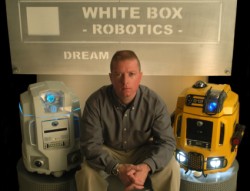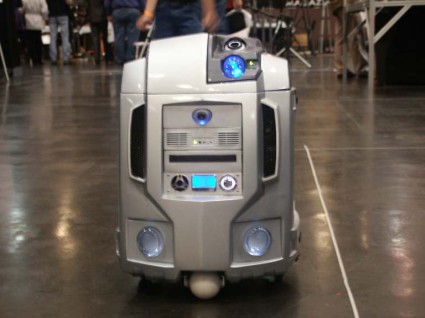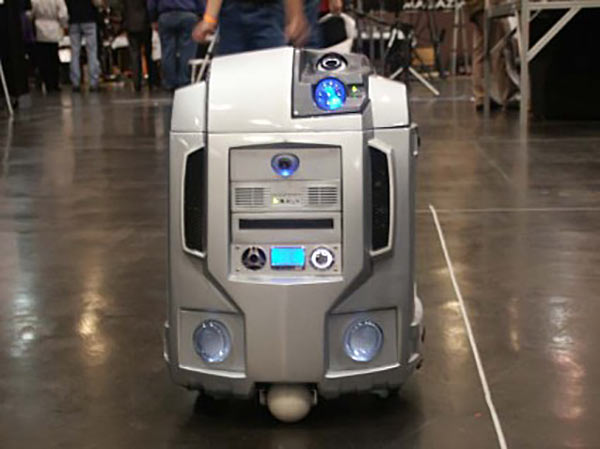For this week’s Engadget Interview, veteran journalist J.D. Lasica caught up with Thomas J. Burick, CEO of White Box Robotics of Youngwood, Penn., at the RoboNexus trade show in Santa Clara, Calif., last month. As robots whirled by on the floor, Burick talked about robots coming down in price to the consumer level, battling PCs for supremacy in the home, and why he didn’t care for “I, Robot.”

Before we get into White Box Robotics, tell me about the field. Robotics has come a long way in the past few years.
It really has. I’ve been working on the 9-series robot for the past five years. Quite honestly I started out by thinking about applying computer parts to robotics in some way because computer boards are so cheap and plentiful, I thought, If we could take them and apply that to personal robots and mobile robots, oh boy. I actually started doing mockups of the robot’s body in 3D and then graduated into several laser-type chassis. That took five years of refinement and then working with our production partner. We’ve come a long way.
A new U.N. report says that 607,000 automated domestic helps were in use at the end of 2003. It seems that the most popular robots purchased by consumers perform manual tasks like yardwork or vacuuming the floors as well as educate or entertain.
Actually, our robots are suitable for any of those applications. There are many commercial applications for our platform, especially security. Commercial security, homeland security, and home security on a consumer level, including facial recognition. With service robots, you could program the robot to run errands. We’re not producing the robot for one specific application, we’re a producer of mobile robotic platforms. We turn them over to customers and other companies and they take it from there, adding their own special electronics and software.
Give me a quick backgrounder on White Box Robotics.
Sure. I started the company five years ago. We’ve been a formal company for about two years. We have six employees. I have a 1,500-square-foot lab and an office facility at the University of Pittsburgh Applied Research Center.

Tell me about some of the robots in your exhibit today.
The basic robot is the 912 (pictured above), the silver one that’s been running around on the floor. You can see some wild, over-the-top concepts in our booth, demonstrating that if you get one of these robots, these are very real things that you can do. Our 912 Apache military concept has the robot sitting in the back of a giant ATV [a Suzuki 500 Vinson provided by Bike World Motor Sports of Sunnyvale, Calif., pictured below]. I actually gave one of my robots to my friends at TransEffects, a Hollywood movie prop studio that does concept cars for General Motors and other manufacturers, and I said, “Guys, here’s a 912, this is what I want. I want tank treads, I want military, I want a lot of weapons.” I didn’t know what to expect, and this showed up the morning before the show. They did an incredible job.
Then there’s the 912 MP3 robot (pictured at right). It’s a multimedia robot that’s a mobile DJ of sorts. You can download MP3s off the Internet, and the robot can roll around at your next party and play MP3s through its built-in satellite subwoofer system. It’s got a DVD movie screen on the back and a PC-based graphic equalizer. You can burn CDs. It’s all off-the-shelf computer parts.
That’s coming out in the first quarter of 2005?
Yes. We’re in the home stretch after five years of development.
What’s it cost?
The bare-bones platform is gonna come in right around $799. For that you get the differential drive system, you get the IO card that controls the motors and the sensors, you get the full chassis and the body panels. From there, you add the motherboard of your choice. You can add a laptop hard drive, a CD-ROM drive and CD burner, and cheap Webcams, and you have a fully functioning robot. We chose to do it that way because the PC and robotics enthusiasts really expressed the idea that maybe I don’t want a 20-gig drive, maybe I want a 120-gig drive, or half a gig of RAM instead of 128.
The DIY platform as an initial platform made a lot of sense because we can get it in the hands of enthusiasts and they can get it out however they want. It’s important to note that we designed the platform to let people cut, drill, paint — it’s a far larger blank canvas than a PC, especially for the mod crowd. It’s DIY, do-it-yourself. At all costs, I want to avoid the word “kit,” because it sounds like a toy or model and these are very serious, real robots.
Are there functionalities that all the DIY robots have in common?
On a basic level, you can still do a lot with the robot. Right out of the box, the robot can pretty effectively guard your house, with object recognition. Telepresence is a big one, too: connect the robot into your wireless network at home and you can access the robot while you’re away. You can check on the house, check on your parents, check on your child or dog. Did you leave the iron on? Send the robot into the room to find out. It has speech synthesis and speech recognition as well.
I didn’t think we were at a point where facial recognition really worked.
It works reasonably well. I was actually surprised. We use the Evolution Robotics RCC software, the application program to control the robot, and I took several shots of my face, and the robot caught me from the side and it was still able to recognize me. In all fairness, it’s not perfect, but it’s fairly accurate, more than you might think.
As far as commercial applications, I could see these robots used in a warehouse. A company might be tempted to replace its security guards, in theory.
Absolutely. They make very inexpensive, almost disposable security guards. A lot of the robots on the market, you’re talking a $40,000 to $60,000 price tag. But with the 912 series, you can build one of these things for a few thousand dollars. A security robotics company could approach us and purchase our platform to do inexpensive security robots, and you’ve got a couple of thousand dollars tied up in one. So what if one of them falls down a flight of stairs or someone cracks a chair over its head? It’s not a major loss on investment.
And companies can recoup their costs fairly fast.
That’s exactly it. Robots don’t show up drunk, they never call in sick.
Do you have any robots at home?
More than you could ever imagine. They’re all through my entire house. All through my office. I always tell people the story of how all the other kids in kindergarten were making clay ashtrays, I was making clay robots. I’ve got a collection from kindergarten on up, so they’re in every cupboard and corner of the house.
Functioning ones, too?
Yes. I have one of our robots guarding the house. I use the robot vacuum on a routine basis in my house and in the lab. Plus, there are the toys I always play with, from a voice-activated R2D2 to robots from “Lost in Space.”
Do you see robots replacing home PCs for some tasks?
Pretty effectively. Our robot will do anything your home computer will do: Internet access, word processing, PC gaming, plus it’s a real robot besides. I think the PC has already been replaced.
In what sense?
Why would you buy a PC when you could have one of these robots that would do all the functions of a PC? I can check my email, I can do all those office applications. But I can also program it to wake me up in the morning. I can program it to guard my house. In that sense, the PC’s already been replaced.
Have you licensed your technology to anyone?
We’ve had considerable interest, but because we’re releasing our first product in the first quarter of 2005, we’re in the middle of that. A number of companies have talked with us about doing an OEM.
This seems like a pretty big trade show for such a young industry. This is the largest one. There have been smaller ones around the country. The shows are bigger in Japan, but there has never been a trade show for robotics on this scale in the United States. It shows the interest is there.
Where do you see the field heading five years down the road?
I think within the next five years you’re going to see just an explosion of robotic products entering the marketplace. In the early to mid-1980s, there was a robotics revolution, but the technology just wasn’t there yet. The manufacturers made promises they couldn’t keep, and the whole market did a crash and burn. I think we’re at a point where there are real technologies we’ve been working on for the past 20 years, and there are real viable technologies going into these robotics. And so I think our second time around — our second revolution — will have real staying power.
Did you see “I, Robot”?
No, I didn’t see it, and I’ll tell you why. Robots really have gotten a bad rap from Hollywood, and it just reinforces the fears people have from the 1950s movies, where the robot breaks in and kills a whole crowd of people. That remains an underlying fear: that robots are going to harm us or take over. So that was my way to rebel, by not seeing the movie.
So robots are our friends.
They’re absolutely our friends. That’s how I see it.









[…] Thomas J. Burick — An interview with the CEO of White Box Robotics about robots coming down in price to the consumer level, how they will battle PCs for supremacy in the home, and why he didn’t care for “I, Robot.” […]